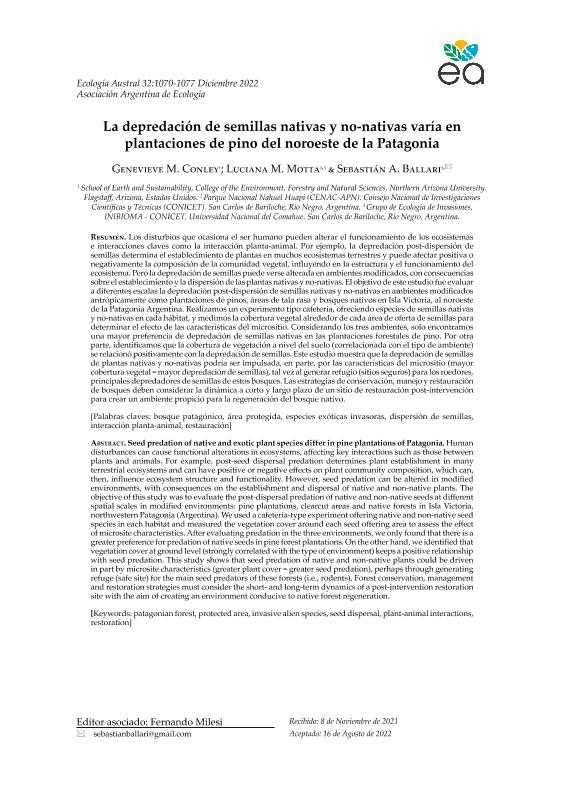Mostrar el registro sencillo del ítem
dc.contributor.author
Conley, Genevieve M.
dc.contributor.author
Motta, Luciana Maria

dc.contributor.author
Ballari, Sebastián A.

dc.date.available
2023-11-09T12:57:52Z
dc.date.issued
2022-12
dc.identifier.citation
Conley, Genevieve M.; Motta, Luciana Maria; Ballari, Sebastián A.; La depredación de semillas nativas y no-nativas varía en plantaciones de pino del noroeste de la Patagonia; Asociación Argentina de Ecología; Ecología Austral; 32; 3; 12-2022; 1070-1077
dc.identifier.issn
0327-5477
dc.identifier.uri
http://hdl.handle.net/11336/217633
dc.description.abstract
Los disturbios que ocasiona el ser humano pueden alterar el funcionamiento de los ecosistemas e interacciones claves como la interacción planta-animal. Por ejemplo, la depredación post-dispersión de semillas determina el establecimiento de plantas en muchos ecosistemas terrestres y puede afectar positiva o negativamente la composición de la comunidad vegetal, influyendo en la estructura y el funcionamiento del ecosistema. Pero la depredación de semillas puede verse alterada en ambientes modificados, con consecuencias sobre el establecimiento y la dispersión de las plantas nativas y no-nativas. El objetivo de este estudio fue evaluar a diferentes escalas la depredación post-dispersión de semillas nativas y no-nativas en ambientes modificados antrópicamente como plantaciones de pinos, áreas de tala rasa y bosques nativos en Isla Victoria, al noroeste de la Patagonia Argentina. Realizamos un experimento tipo cafetería, ofreciendo especies de semillas nativas y no-nativas en cada hábitat, y medimos la cobertura vegetal alrededor de cada área de oferta de semillas para determinar el efecto de las características del micrositio. Considerando los tres ambientes, solo encontramos una mayor preferencia de depredación de semillas nativas en las plantaciones forestales de pino. Por otra parte, identificamos que la cobertura de vegetación a nivel del suelo (correlacionada con el tipo de ambiente) se relacionó positivamente con la depredación de semillas. Este estudio muestra que la depredación de semillas de plantas nativas y no-nativas podría ser impulsada, en parte, por las características del micrositio (mayor cobertura vegetal = mayor depredación de semillas), tal vez al generar refugio (sitios seguros) para los roedores, principales depredadores de semillas de estos bosques. Las estrategias de conservación, manejo y restauración de bosques deben considerar la dinámica a corto y largo plazo de un sitio de restauración post-intervención para crear un ambiente propicio para la regeneración del bosque nativo.
dc.description.abstract
Human disturbances can cause functional alterations in ecosystems, affecting key interactions such as those between plants and animals. For example, post-seed dispersal predation determines plant establishment in many terrestrial ecosystems and can have positive or negative effects on plant community composition, which can, then, influence ecosystem structure and functionality. However, seed predation can be altered in modified environments, with consequences on the establishment and dispersal of native and non-native plants. The objective of this study was to evaluate the post-dispersal predation of native and non-native seeds at different spatial scales in modified environments: pine plantations, clearcut areas and native forests in Isla Victoria, northwestern Patagonia (Argentina). We used a cafeteria-type experiment offering native and non-native seed species in each habitat and measured the vegetation cover around each seed offering area to assess the effect of microsite characteristics. After evaluating predation in the three environments, we only found that there is a greater preference for predation of native seeds in pine forest plantations. On the other hand, we identified that vegetation cover at ground level (strongly correlated with the type of environment) keeps a positive relationship with seed predation. This study shows that seed predation of native and non-native plants could be driven in part by microsite characteristics (greater plant cover = greater seed predation), perhaps through generating refuge (safe site) for the main seed predators of these forests (i.e., rodents). Forest conservation, management and restoration strategies must consider the short-and long-term dynamics of a post-intervention restoration site with the aim of creating an environment conducive to native forest regeneration.
dc.format
application/pdf
dc.language.iso
spa
dc.publisher
Asociación Argentina de Ecología

dc.rights
info:eu-repo/semantics/openAccess
dc.rights.uri
https://creativecommons.org/licenses/by/2.5/ar/
dc.subject
INVASIVE ALIEN SPECIES
dc.subject
PATAGONIAN FOREST
dc.subject
PLANT-ANIMAL INTERACTIONS
dc.subject
PROTECTED AREA
dc.subject
RESTORATION
dc.subject
SEED DISPERSAL
dc.subject.classification
Ecología

dc.subject.classification
Ciencias Biológicas

dc.subject.classification
CIENCIAS NATURALES Y EXACTAS

dc.title
La depredación de semillas nativas y no-nativas varía en plantaciones de pino del noroeste de la Patagonia
dc.title
Seed predation of native and exotic plant species differ in pine plantations of Patagonia
dc.type
info:eu-repo/semantics/article
dc.type
info:ar-repo/semantics/artículo
dc.type
info:eu-repo/semantics/publishedVersion
dc.date.updated
2023-11-08T13:08:13Z
dc.journal.volume
32
dc.journal.number
3
dc.journal.pagination
1070-1077
dc.journal.pais
Argentina

dc.description.fil
Fil: Conley, Genevieve M.. Northern Arizona University; Estados Unidos
dc.description.fil
Fil: Motta, Luciana Maria. Consejo Nacional de Investigaciones Científicas y Técnicas. Centro Científico Tecnológico Conicet - Patagonia Norte. Instituto de Investigaciones en Biodiversidad y Medioambiente. Universidad Nacional del Comahue. Centro Regional Universidad Bariloche. Instituto de Investigaciones en Biodiversidad y Medioambiente; Argentina
dc.description.fil
Fil: Ballari, Sebastián A.. Administración de Parques Nacionales. Parque Nacional "Nahuel Huapi"; Argentina. Consejo Nacional de Investigaciones Científicas y Técnicas. Centro Científico Tecnológico Conicet - Patagonia Norte; Argentina
dc.journal.title
Ecología Austral

dc.relation.alternativeid
info:eu-repo/semantics/altIdentifier/doi/http://dx.doi.org/10.25260/EA.22.32.3.0.1876
Archivos asociados
